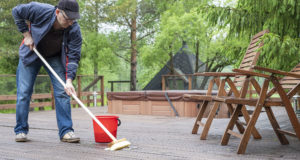Why You Should Never Pressure Wash Your Deck
By Dave KileThis year you may have enjoyed more time out on your deck. Soaking up the sun in your garden has been good therapy and a relaxing way to spend a summer day.
However, as the season has worn on, you’ve noticed more details: The leaves that build up in the corner. The tannin spots that have bloomed around your planters. The colorful punch spill left by a child. The mildew that’s spreading where your gutter has sprung a leak.
You’re ready to clean every nook of your deck and get ready for a new season. You may also want to apply a fresh coat of sealant or deck stain. Either way, you are ready to restore its shine. Should pressure washing be part of your deck cleaning routine?
Beware Pressure Washing Damage
Using a pressure washer may seem like a quick and easy way to clear out all the accumulated dirt and grime; however, you need to be aware of the damage it may cause. For example, a power washer’s pressure may cause splintering and damage to the wood fibers if you have wood deck boards. If the wood surface already has some splintering, pressure washing will only exacerbate the issue.
You may have already heard about the problems of pressure washing a wood deck. But what about composite decking? Depending on the material, a power washer can also scar boards if the pressure is too high. If the power washing becomes too intense, it can even chip the material.
If you damage your composite deck with a vigorous power wash, it can affect the warranty. Damage caused by using high-pressure washing is generally not covered, so you would have to pay for your repairs.
If you’ve installed quality composite decking such as Trex, you should wash it semi-annually (spring and autumn are the most conducive to the weather). Trex recommends a basic cleaning with a composite deck cleaner or a combination of soap, hot water, and a soft-bristle brush. Note: Using products containing bleach or acid will lighten the surface of Trex.
Is it Ever OK to Power Wash a Deck?
The biggest issue with power washing is the pressure. You may be able to use a low-pressure setting to aid in your cleaning; however, it is recommended to leave this to the professionals.
If you DIY this project:
- Hold the power washer at least two feet off the ground.
- Use a pressure washer with a fan tip attachment/adjustment and a soap dispenser to remove soil, concrete dust, or other soil types.
- Spray the deck with soap, then follow by gently scrubbing each deck board with a soft bristle brush.
- Rinse thoroughly. If dirty water from cleaning is left to dry, it will cause a film to remain on the decking surface.
If hiring a professional, be sure to ask for someone with deck experience and suggest using a relatively low-pressure setting (usually adjust the sprayer pressure to 1,500 PSI or lower).
Cleaning Without a Power Washer
The safest route for cleaning your deck is soap and water. For basic deck cleaning, you’ll need the following:
- A broom
- A garden hose
- A bristle brush
- A biodegradable deck-cleaning solution (dish soap can work fine); avoid bleach and acid solutions unless you’ve tested them on a small area not highly visible
Here is a simple step-by-step process for cleaning without a power washer:
- Remove furniture and any other objects from the deck boards.
- Sweep off any leaves or other debris from your deck.
- Test your cleaner on a small area to be sure there is no staining.
- Clean with water, a cleaning solution, and a bristle brush.
- Scrub the entire deck.
- Rinse off with a hose. Be sure it’s completely rinsed, so it doesn’t leave a film.
- Let the deck completely dry before moving furniture and décor back onto the deck.
Cleaning by Situation: Not every clean-up situation is the same. Trex offers the following tips for cleaning your composite deck, depending on your particular challenge.
For Dirt and Debris: The affected area should be sprayed off with a hose to remove surface debris. Use warm, soapy water and a soft-bristle brush to remove soil and debris from the embossing pattern.
Tannin Due to Debris: Remove all debris from the deck using a hose or broom. Once the deck surface is dry, apply a “deck brightener” to the deck as directed by the manufacturer. Deck brighteners contain oxalic acid, which will remove tannins.
Chalk Lines: High permanence chalk lines may discolor the surface. Use only Irwin Strait-Line® Dust-Off Marking Chalk (purple) available at www.Irwin.com.
Oil and Grease: Remove all food spills as soon as possible. The surface must be cleaned within seven days to maintain the stain warranty. To remove, spray off with a hose and use warm, soapy water and a soft-bristle brush to remove spills from the embossing pattern.
Mold and Mildew: If debris, such as pollen and soil, remains on the deck surface, mold can feed on the biofilm. Using a hose and warm, soapy water with a soft bristle brush is recommended to remove the food source and mold.
Make plans for a new deck if your deck has reached the point of no return — it’s beyond stripping, sanding, re-staining, and repairing. To protect your deck in all seasons, be sure to use a flashing tape such as Trex Protect. With its superior waterproofing power and your deck cleaning skills, you can enjoy an outdoor living space for years to come!

